Analysis of Damage and Permeability Evolution for Mudstone Material under Coupled Stress-Seepage
Abstract
1. Introduction
2. Stress-Seepage Damage Coupling Model
2.1. Elastoplastic Damage Constitutive Equation
2.2. Stress Balance Equation
2.3. Continuous Equation
3. Permeability Evolution Model of Mudstone Material
3.1. Percolation Characteristics of Mudstone Material
3.2. Permeability Evolution Model
4. Numerical Simulation and Application
4.1. Numerical Model Validation
4.2. Application of Proposed Model
5. Conclusions
- (1)
- Permeability variation curves includes three stages, namely permeability reduction, permeability growth and permeability stability, during the deformation process of mudstone. Furthermore, there is a sudden permeability change after rock capacity expansion, which is called the percolation characteristic of mudstone.
- (2)
- The percolation characteristics of mudstone is mainly caused by propagation and forming an infinite group of micro-cracks during the loading process.
- (3)
- Based on percolation theory, the permeability evolution equation describing the micro-macro hydraulic behavior of mudstone is deduced. Furthermore, a damage variable is introduced into the proposed model based on the principle of minimum energy consumption and seepage-stress damage coupling model of mudstone is established.
- (4)
- The proposed stress-seepage damage coupling model was embedded into commercial finite element code-ABAQUS, and the numerical codes were validated by comparing experimental and numerical results.
- (5)
- The proposed theoretical and numerical modes were applied on a roadway construction process. The results show that over time pore pressure first increases and then decreases, while damage and the permeability coefficient gradually increase and finally nearly remain constant.
Author Contributions
Funding
Conflicts of Interest
References
- Jia, Y.; Bian, H.B.; Duveau, G. Hydromechanical modelling of shaft excavation in Meuse/Haute-Marne laboratory. Phys. Chem. Earth 2008, 33, S422–S435. [Google Scholar] [CrossRef]
- Levasseur, S.; Charlier, R.; Frieg, B. Hydro-mechanical modeling of the excavation damaged zone around an underground excavation at Mont Terri Rock Laboratory. Int. J. Rock Mech. Min. Sci. 2010, 47, 414–425. [Google Scholar] [CrossRef]
- Marcke, P.V.; Bastiaens, W. Excavation induced fractures in a plastic clay formation: Observations at the HADES URF. J. Struc. Geol. 2010, 32, 1677–1684. [Google Scholar] [CrossRef]
- Deng, Y.F.; Tang, A.M.; Cui, Y.J. Laboratory hydro-mechanical characterisation of Boom Clay at Essen and Mol. Phys. Chem. Earth 2011, 36, 1878–1890. [Google Scholar] [CrossRef]
- Yang, T.H.; Li, L.C.; Tang, C.A. Analysis on the relationship between seepage and damage during the failure process of rocks-author’s reply to Doctor Tang Hongxia’s discussion. Chin. J. Rock Mech. Eng. 2004, 23, 4254–4257. [Google Scholar]
- Ziefle, G.; Matray, J.; Jobst, M. Coupled hydraulic-mechanical simulation of seasonally induced processes in the Mont Terri rock laboratory (Switzerland). Swiss. J. Geosci. 2017, 110, 195–212. [Google Scholar] [CrossRef]
- Liu, X.; Liu, Q.; Liu, B.; Kang, Y.; He, J. Numerical manifold method for thermal–hydraulic coupling in fractured enhance geothermal system. Eng. Anal. Bound. Elem. 2019, 101, 67–75. [Google Scholar] [CrossRef]
- Liu, X.; Liu, Q.; Liu, B.; Zhu, Y.; Zhang, P. Failure Behavior for Rocklike Material with Cross Crack under Biaxial Compression. J. Mater. Civ. Eng. 2019, 31, 06018025. [Google Scholar] [CrossRef]
- Liu, X.; Liu, Q.; Wei, L.; Huang, X. Improved strength criterion and numerical manifold method for fracture initiation and propagation. Int. J. Geomech. 2017, 17, E4016007. [Google Scholar] [CrossRef]
- Xiao, Y.X.; Lee, C.F.; Wang, S.J. Assessment of an equivalent porous medium for coupled stress and fluid flow in fractured rock. Int. J. Rock Mech. Min. Sci. 1999, 36, 871–881. [Google Scholar] [CrossRef]
- Kelsall, P.C.; Case, J.B.; Chabannes, C.R. Evaluation of exeavation-indueed changes in rock permeability. Int. J. Rock Mech. Min. Sci. Geomech. Abstr. 1984, 21, 123–135. [Google Scholar] [CrossRef]
- Yang, Y.Z.; Zhou, W.Y. A coupled seepage-damage analysis model for jointed rock masses and its application to rock engineering. J. Hydraul. Eng. 1991, 35, 19–27. [Google Scholar]
- Zhang, L.; Lu, G.H. Application of damage-based permeability-stress coupling model to studies on groundwater migration. Adv. Sci. Technol. Water Resour. 2010, 30, 58–62. [Google Scholar]
- Ran, X.F.; Wang, Y.Z.; Jia, S.P. Research on borehole stability of shale based on seepage-stress-damage coupling model. Frattura ed Integrità Strutturale 2014, 27, 74–82. [Google Scholar] [CrossRef]
- Liu, X.; Liu, Q.; Liu, B.; Kang, Y. A Modified Bursting Energy Index for Evaluating Coal Burst Proneness and Its Application in Ordos Coalfield, China. Energies 2020, 13, 1729. [Google Scholar] [CrossRef]
- Liu, B.; Zhu, Y.; Liu, Q.; Liu, X. A Novel in Situ Stress Monitoring Technique for Fracture Rock Mass and Its Application in Deep Coal Mines. Appl. Sci. 2019, 9, 3742. [Google Scholar] [CrossRef]
- Liu, X.; Liu, Q.; Kang, Y.; Liu, B. Investigation on relationship of the burial depth and mechanical properties for sedimentary rock. Arab. J. Geosci. 2020, 13, 760. [Google Scholar] [CrossRef]
- Liu, X.; Liu, Q.; He, J.; Yu, F. Numerical simulation of cracking process in rock mass under the coupled thermo-mechanical condition. Int. J. Comput. Methods 2020, 17, 1950065. [Google Scholar] [CrossRef]
- Schulte, R.; Ostwald, R.; Menzel, A. Gradient-Enhanced Modelling of Damage for Rate-Dependent Material Behaviour—A Parameter Identification Framework. Materials 2020, 13, 3156. [Google Scholar] [CrossRef]
- Niu, J.; Wang, B.; Feng, C.; Chen, K. Experimental Research on Viscosity Characteristics of Grouting Slurry in a High Ground Temperature Environment. Materials 2020, 13, 3221. [Google Scholar] [CrossRef]
- Choi, C.S.; Lee, Y.K.; Song, J.J. Equivalent Pore Channel Model for Fluid Flow in Rock Based on Microscale X-ray CT Imaging. Materials 2020, 13, 2619. [Google Scholar] [CrossRef]
- Li, H.; Zhang, Q.; Jia, J.; Ji, C.; Wang, B.; Yan, S. Study on Low-Velocity Impact Damage and Residual Strength of Reinforced Composite Skin Structure. Materials 2020, 13, 2573. [Google Scholar] [CrossRef] [PubMed]
- Skrzypkowski, K. Case Studies of Rock Bolt Support Loads and Rock Mass Monitoring for the Room and Pillar Method in the Legnica-Głogów Copper District in Poland. Energies 2020, 13, 2998. [Google Scholar] [CrossRef]
- Li, J.L. Study on the Seepage-Stress-Damage Coupling Model and Permeability Self-Healing of Clay. Ph.D. Thesis, Wuhan University, Wuhan, China, 2014. [Google Scholar]
- Tang, C.A. The Catastrophe in the Process of Rock Failure; Coal Industry Press: Beijing, China, 1993. [Google Scholar]
- Li, P.C.; Kong, X.Y.; Lu, D.T. Mathematical modeling of flow in saturated porous media on account of fluid-structure coupling effect. J. Hydrodyn. 2003, 18, 419–426. [Google Scholar]
- Scuro, C.; Tiberti, S.; Codispoti, R.; Milani, G.; Olivito, R.S. Fictile tubules: A traditional Mediterranean construction technique for masonry vaulted systems. Constr. Build. Mater. 2018, 193, 84–96. [Google Scholar] [CrossRef]
- Yu, H. Study on Long Term Hydro-Mechanical Coupled Behavior of Belgium Boom Clay. Ph.D. Thesis, Institute of Rock and Soil Mechanics, Chinese Academy of Sciences, Wuhan, China, 2010. [Google Scholar]
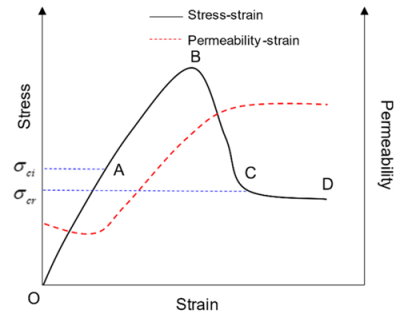

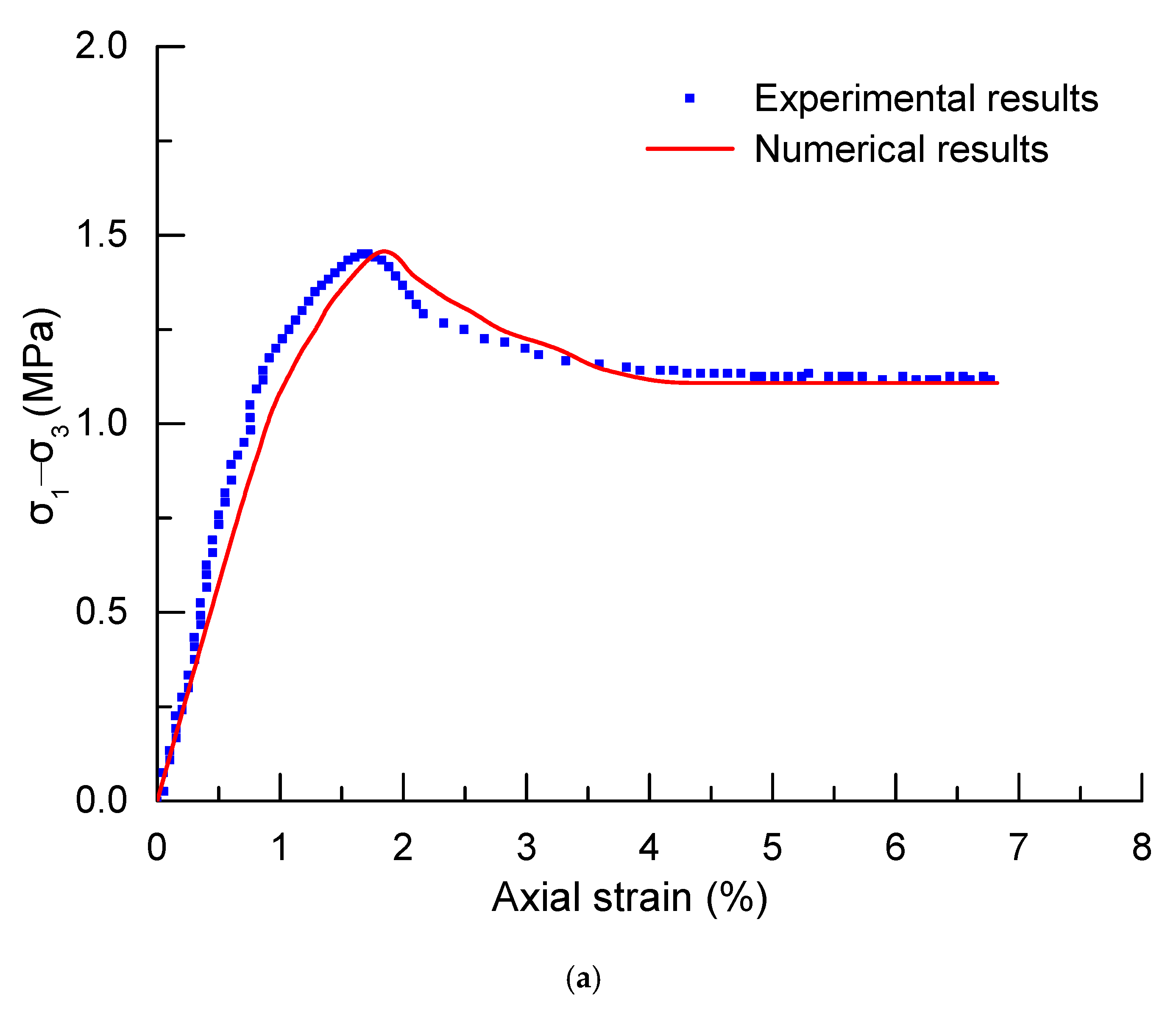
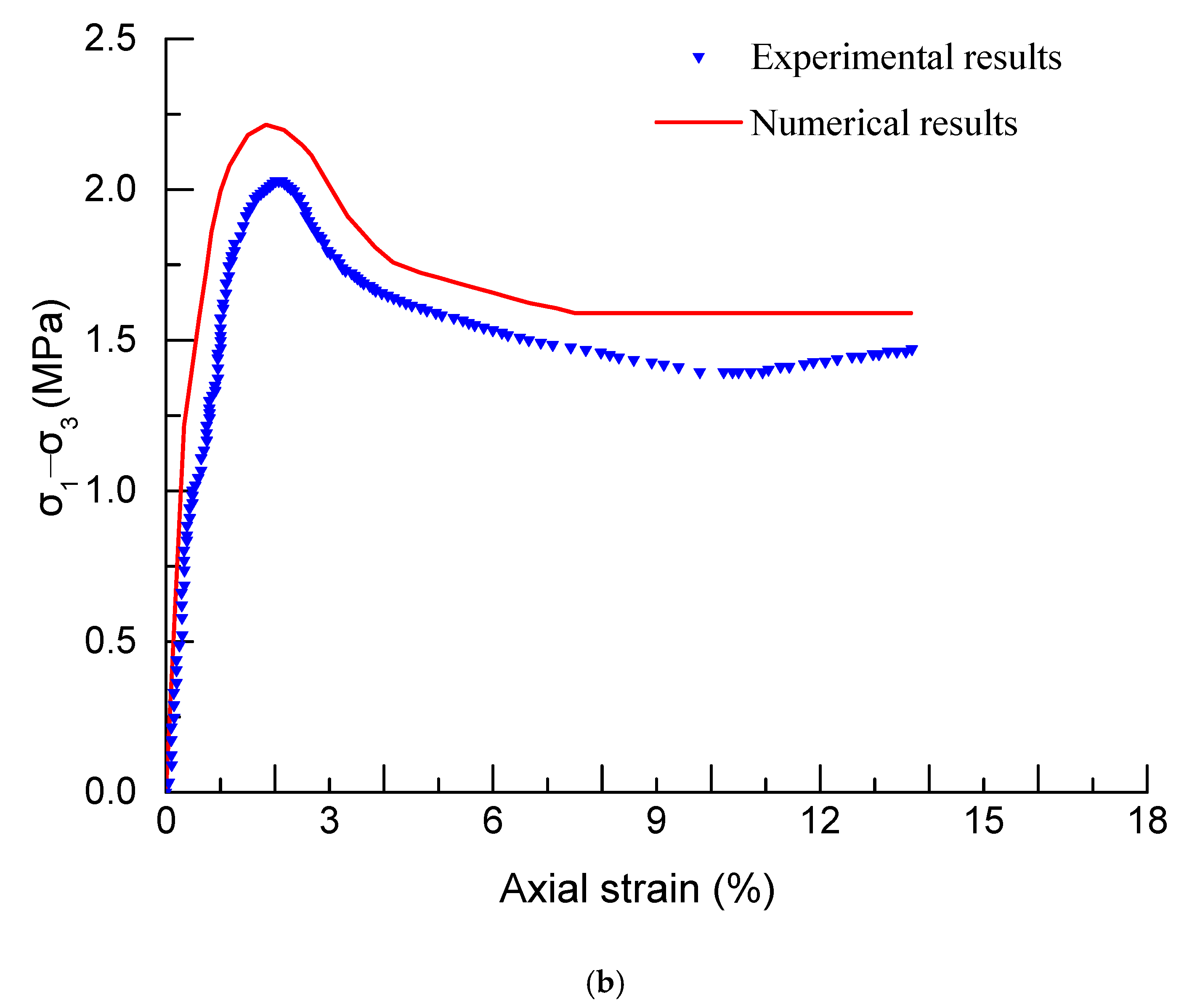
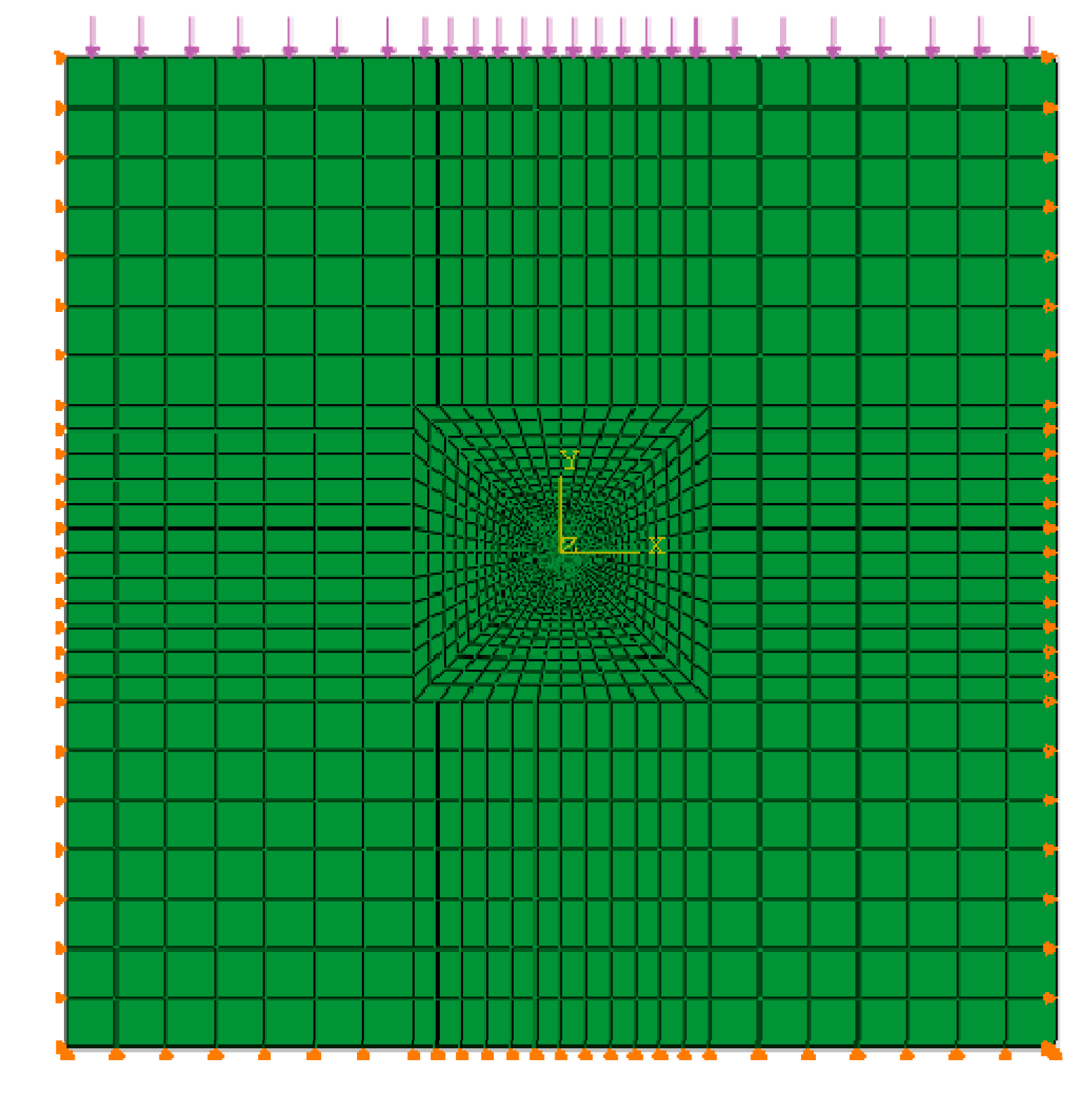
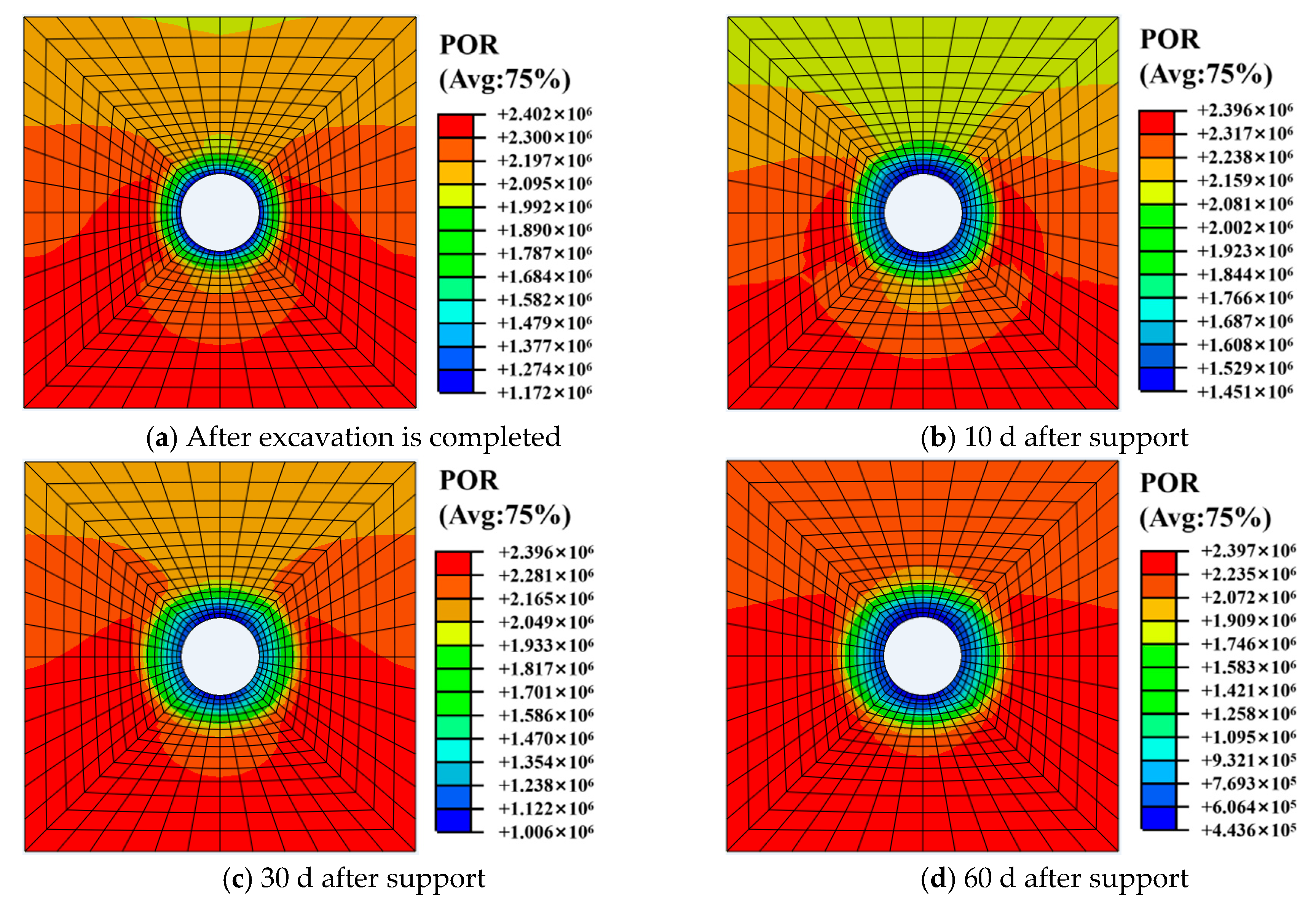
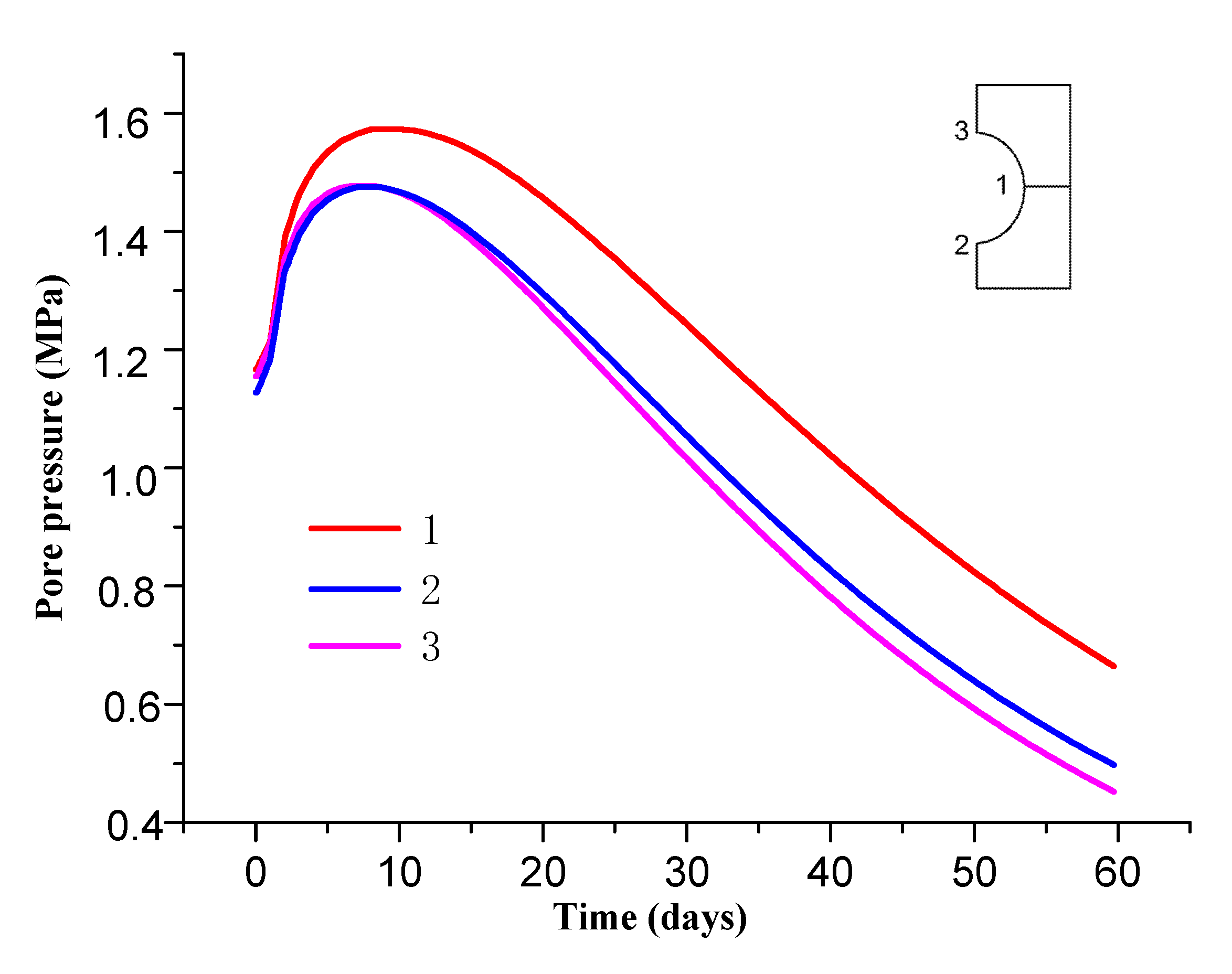

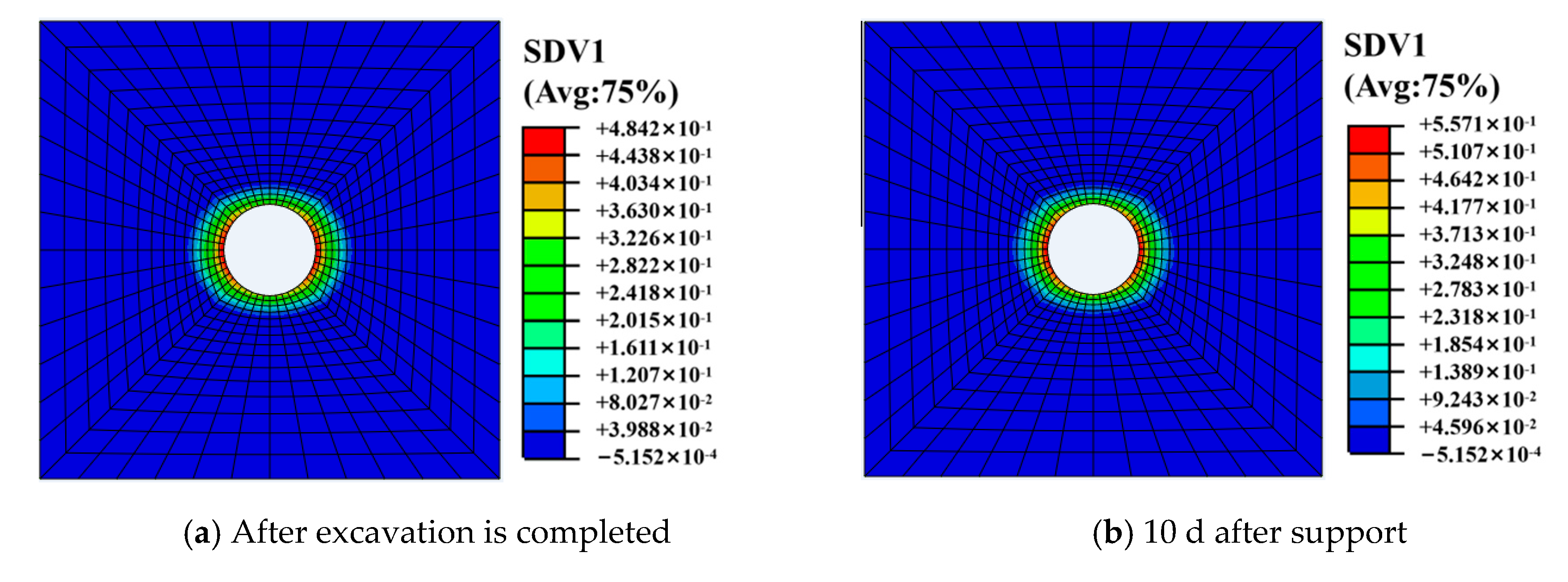
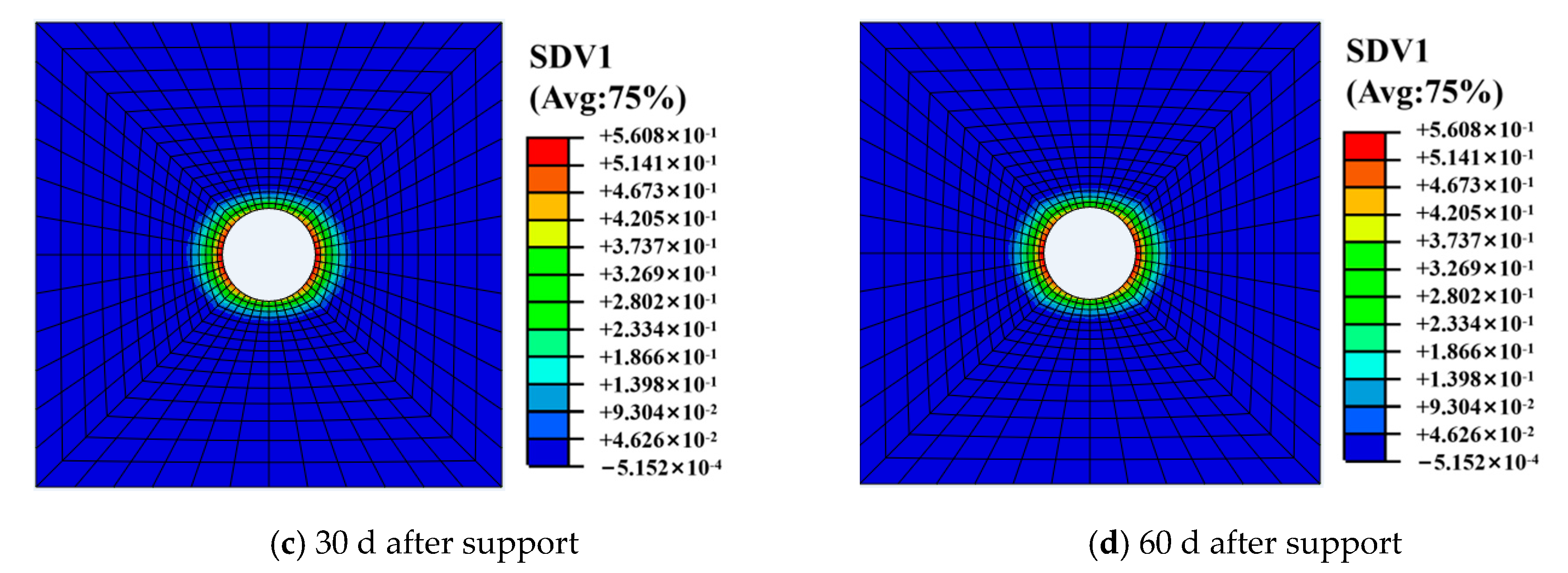

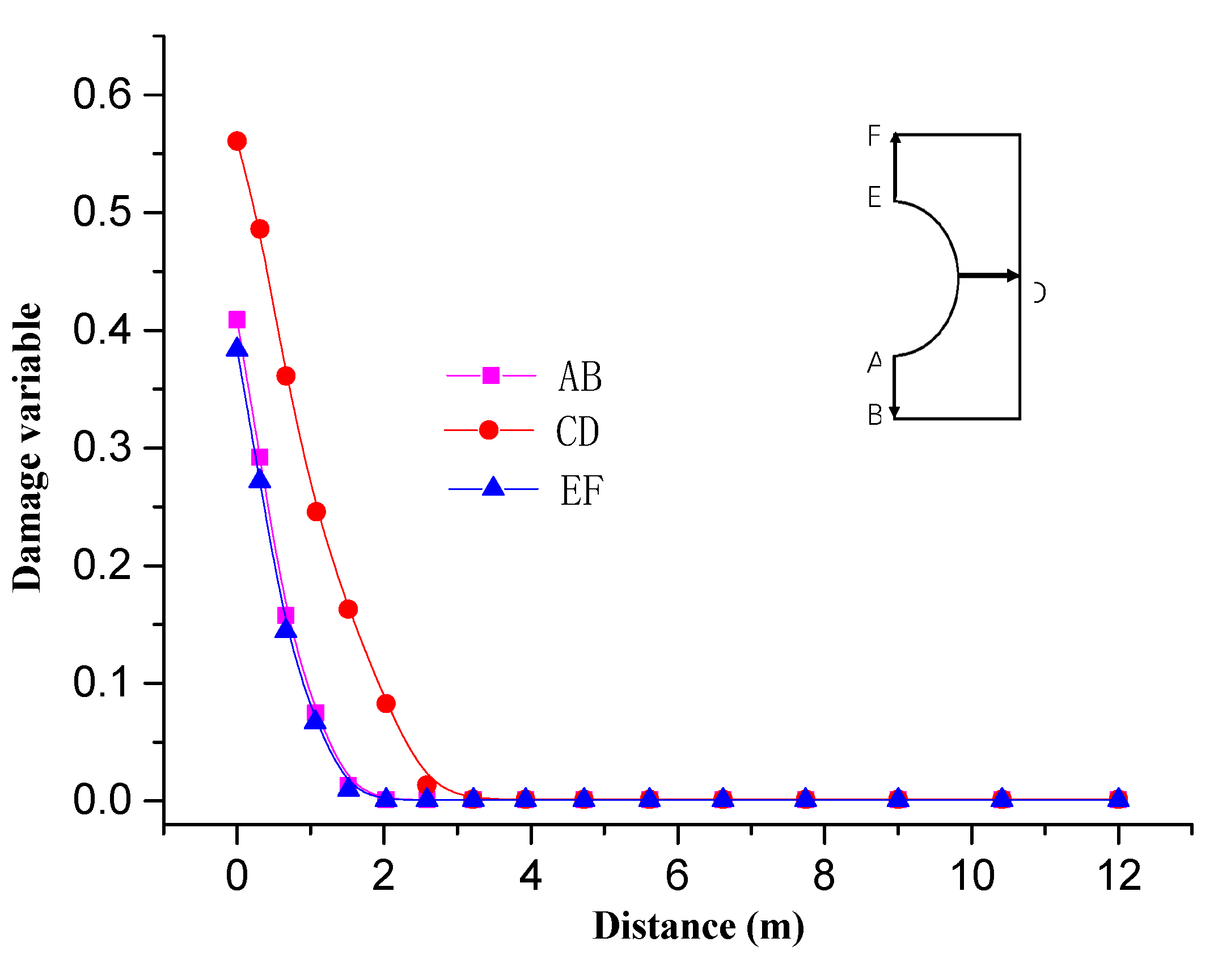
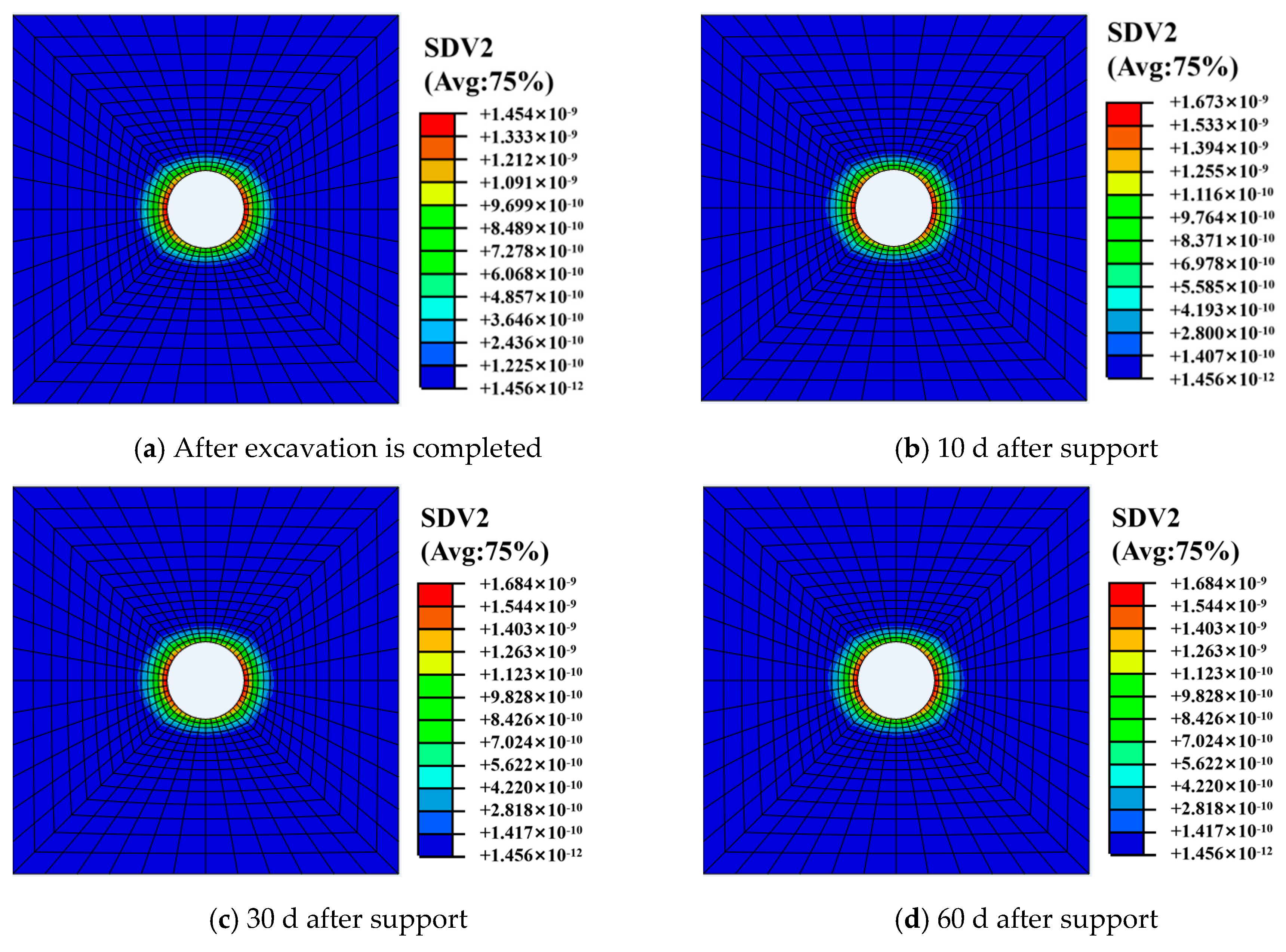
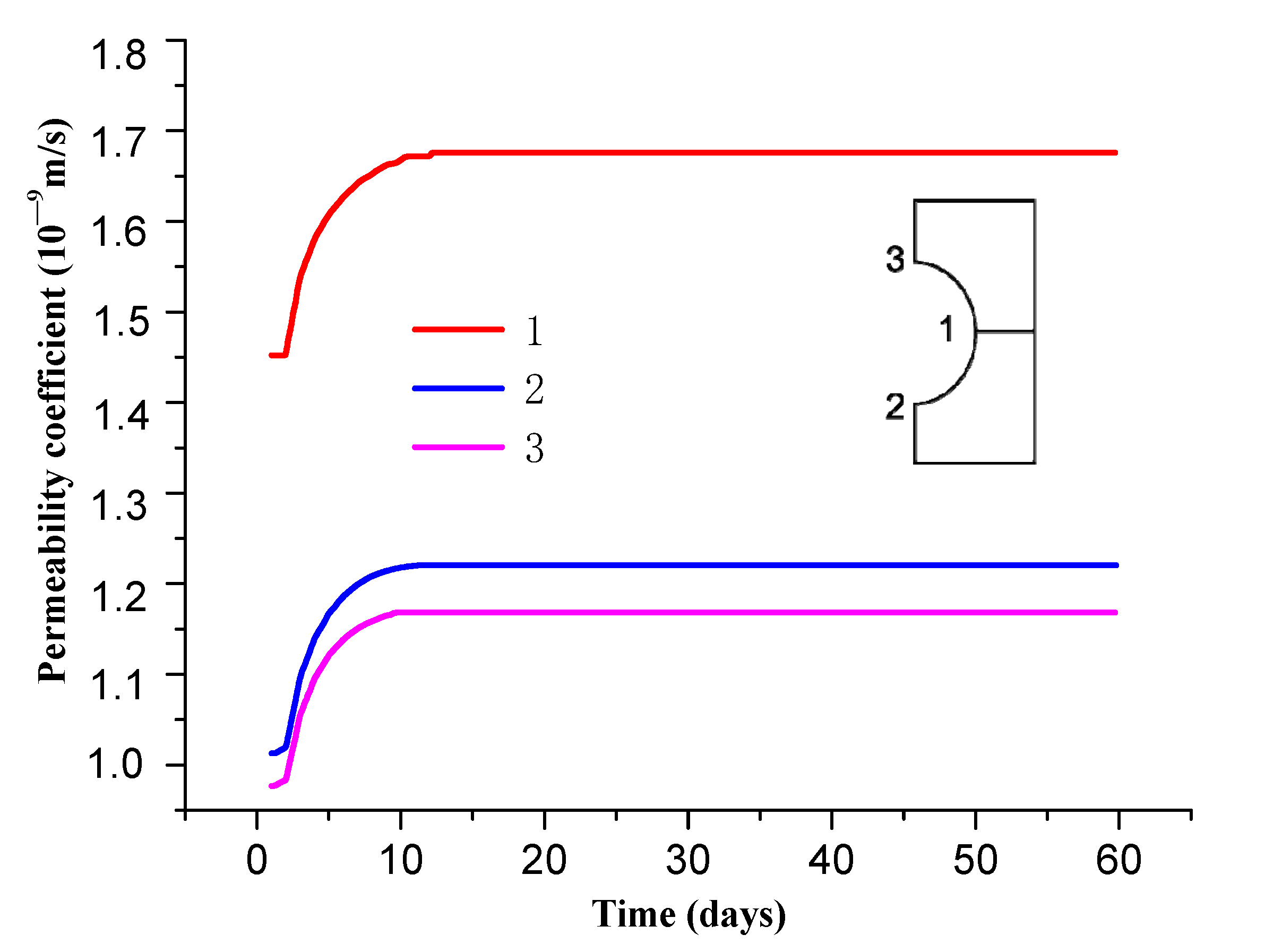
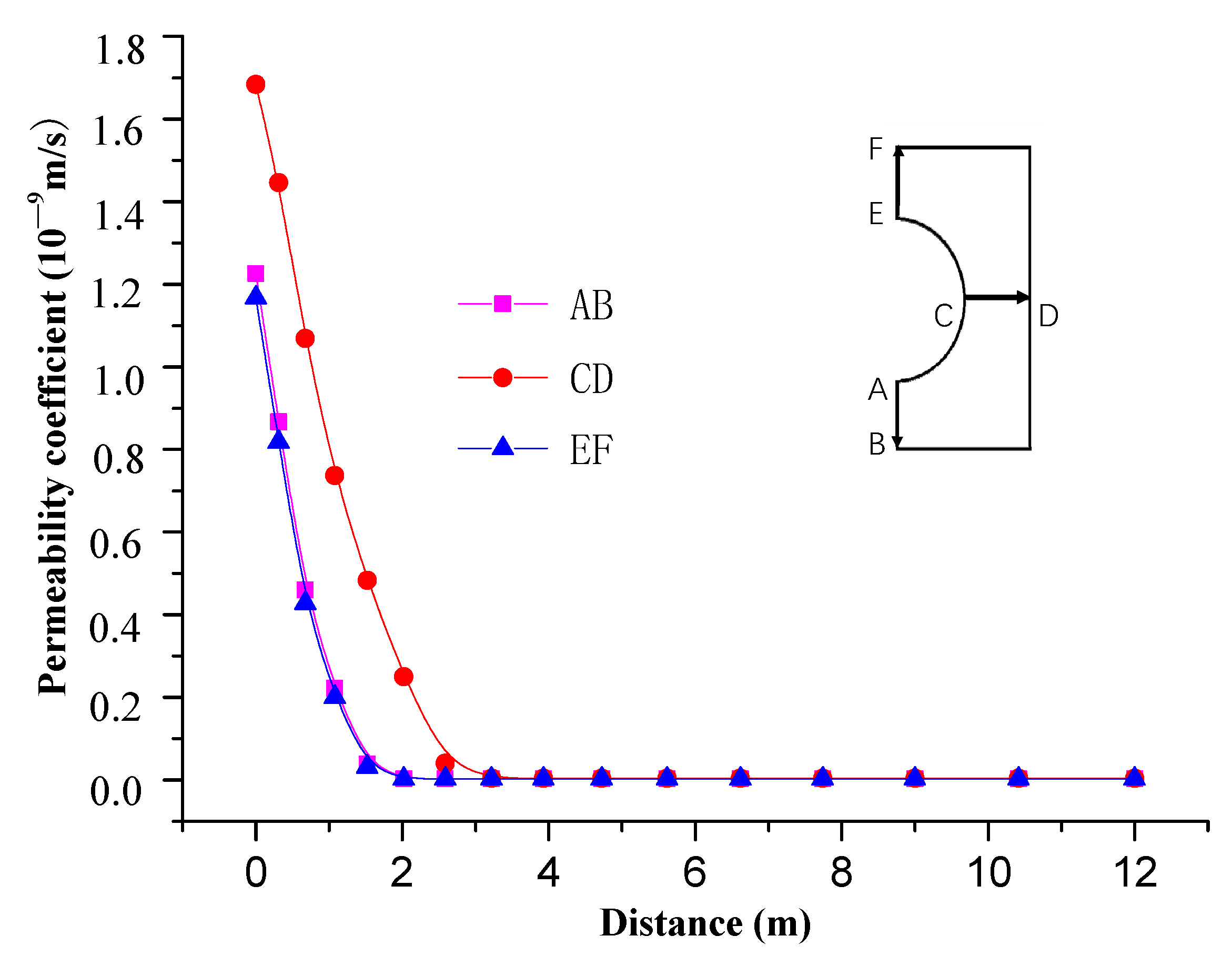
| Weight (kN/m3) | Elasticity Modulus (GPa) | Poisson’s Ratio | Cohesion (MPa) | Residual Cohesion (MPa) | Internal Friction Angle (°) | Permeability Coefficient (m/s) | Porosity | |
|---|---|---|---|---|---|---|---|---|
| Mudstone | 20 | 0.6 | 0.13 | 0.3 | 0.06 | 19 | 3 × 10−12 | 0.39 |
| Lining | 25 | 20 | 0.25 | - | - | - | 1.2 × 10−11 | 0.06 |
© 2020 by the authors. Licensee MDPI, Basel, Switzerland. This article is an open access article distributed under the terms and conditions of the Creative Commons Attribution (CC BY) license (http://creativecommons.org/licenses/by/4.0/).
Share and Cite
Liu, B.; Li, J.; Liu, Q.; Liu, X. Analysis of Damage and Permeability Evolution for Mudstone Material under Coupled Stress-Seepage. Materials 2020, 13, 3755. https://doi.org/10.3390/ma13173755
Liu B, Li J, Liu Q, Liu X. Analysis of Damage and Permeability Evolution for Mudstone Material under Coupled Stress-Seepage. Materials. 2020; 13(17):3755. https://doi.org/10.3390/ma13173755
Chicago/Turabian StyleLiu, Bin, Jinlan Li, Quansheng Liu, and Xuewei Liu. 2020. "Analysis of Damage and Permeability Evolution for Mudstone Material under Coupled Stress-Seepage" Materials 13, no. 17: 3755. https://doi.org/10.3390/ma13173755
APA StyleLiu, B., Li, J., Liu, Q., & Liu, X. (2020). Analysis of Damage and Permeability Evolution for Mudstone Material under Coupled Stress-Seepage. Materials, 13(17), 3755. https://doi.org/10.3390/ma13173755





